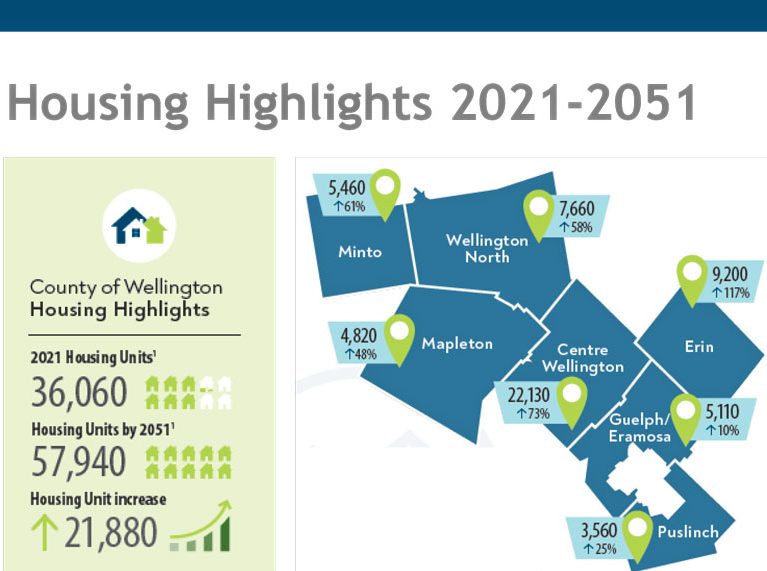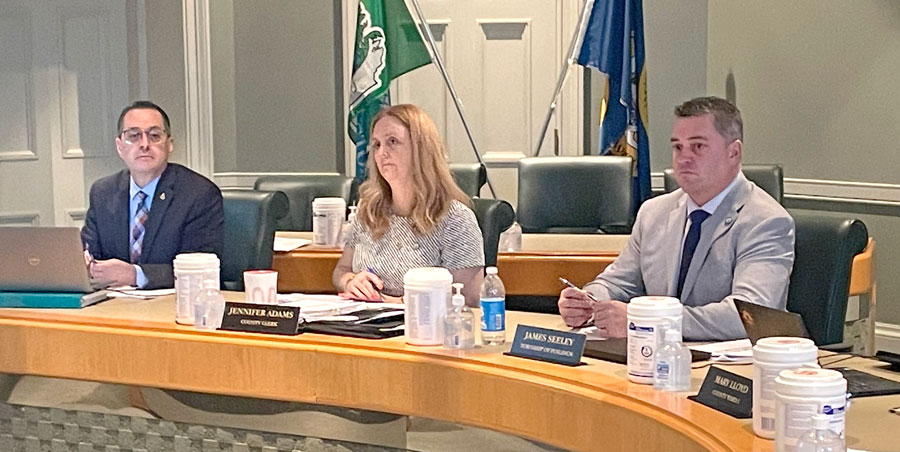GUELPH – Potential loss of farmland to urban expansion and distribution of growth among member municipalities were two of the concerns raised at a public meeting on an official plan amendment (OPA) designed to address provincial growth projections for Wellington County.
The county is in the midst of a municipal comprehensive review (MCR) process and the proposed amendment, OPA 120, will update the growth forecast for Wellington County and member municipalities to 2051. Previous forecasts only projected as far as 2041.
In 2020, the provincial government approved an amendment to its 2019 growth plan.
The amendment revised population and employment forecasts for all Greater Golden Horseshoe area municipalities, including Wellington County to the year 2051.
The forecasts for Wellington County project a minimum population of 160,000 and employment of 70,000. This represents an increase of over 59,000 people and almost 27,000 jobs over the next 30 years.
The plan requires the county to distribute this growth across Wellington.
“What that looks like is just over a third to Centre Wellington, about a third combined to the northern municipalities, Wellington North, Minto and Mapleton, 16 per cent to Erin and combined Guelph/Eramosa and Puslinch about 15%,” explained Sarah Wilhelm, the county’s manager of planning and policy at a public meeting on Jan. 12 in Guelph.
“Across Wellington County the increase anticipated is almost 22,000 housing units over the next 30 years, which averages out to about 730 housing units per year,” she added.
“The highest increases are in Centre Wellington and, due to anticipated municipal services, also in the Town of Erin.”
Wilhelm noted, “We’re looking at an increase of approximately 27,000 jobs in the county, almost half of which are allocated to Centre Wellington.
“There’s a small 3% increase for Guelph/Eramosa and otherwise we’re looking in the eight to 12% range for all of the other member municipalities.”
Wilhelm pointed out changes to land use designations or policies related to a land assessment and urban boundaries review “will be part of our future ongoing work.”
A staff report on the land needs assessment presented to county council on Sept. 27 indicates the county has an overall shortfall of about 677 hectares (1,700 acres) of designated land to meet urban growth forecasts to 2051.
How that shortfall is made up is of concern to the local farming community, said Wellington Federation of Agriculture (WFA) chair Janet Harrop.
“The county has identified in their official plan the importance of agriculture. So we’re continuing to ask clarification of exactly what that means,” said Harrop during the meeting.
“We realize that there will be urban boundary expansion and the only way to expand urban boundaries is to pave over farmland, so we’re wanting to be part of this discussion.”
Harrop pointed out research done by professor Wayne Caldwell at the University of Guelph shows that in Wellington County, through official plan amendments, land was converted to urban residential and employment lands “to the tune of 1,800 acres” during a 16-year period between 2000 and 2016.
“In that same period of time, almost 35,000 acres in Wellington County was allocated from a previous zoning to secondary agriculture,” Harrop explained.
“And we’re starting to see, as Wellington is such a place that people want to move to, that there are increasing requests for secondary ag land and it’s not for the purposes of farming.
“It’s to be able to severe additional residential lot to be able to then, in turn, sell them and use that income to be able to partially help them purchase the property in the first place.”
Harrop continued, “What we’re seeing really fragments agriculture. We kind of call it death by a thousand cuts … it’s a little bit here and a little bit there, a little bit there.
“But then over a period of time when you look back and it’s 35,000 acres, that’s a lot of land.”
Harrop said the numbers are “sobering” and suggested county officials should “stop and think, what are we doing in terms of our agricultural system.
“Because the county has a very extensive, very productive agricultural system, meaning processing and farming, manufacturing … the whole supply chain and that really needs to stay intact,” she added.
Harrop said a proposed 15% intensification target for urban areas in the county is too low.
“The federation is recommending much higher. We would like to see 25, or at least the 20 that the province is recommending,” she said.
“You reduce the intensification in the urban areas … that means more pushing out onto farmland.”
“I understand your position. You want to protect farmland from sprawl and growth. Does that account for all types of growth on farmland?” asked county councillor James Seeley, who chairs the county’s planning committee.
Seeley noted industrial expansion has also taken place on farmland in the county in some cases and he asked Harrop to clarify the WFA’s position on that type of development.
“Are we advocating for zero growth of any kind on agricultural land, or were you just more focused on the residential?” asked Seeley.
“Well, fundamentally, the Wellington Federation of Agriculture and the Ontario Federation of Agriculture’s comments would be they want to see no additional farmland [removed from] agricultural production,” Harrop replied.
“We’re also realistic and know that with the current growth that means that’s likely not going to happen. But that is certainly what we would be advocating for.”

Provincial growth projections anticipate a total of 57,940 housing units will be required in Wellington County by 2051. This illustration shows how the housing units will be distributed across member municipalities. County agenda image
Puslinch resident John Sloot, who runs a construction business from Arkell, pointed out residential development helps reduce commute times for workers, including those in the agricultural industry.
“Yes, farms have to be protected. But farming has changed dramatically in the last bunch of years,” said Sloot.
“We have a state-of-the-world facility here in the University of Guelph and their main object is to promote agriculture and find better ways to farm.”
Sloot added, “And what we don’t consider a lot of times is these farms that used to be run by one family are now run by 10 people? And where do those 10 people come from? If they’re commuting from far distances, that’s not really helping this system either.
“In Puslinch, there are half-acre lots. Why does every severance have to be an acre minimum?” “Sloot asked.
“Septics have become so much more advanced that we don’t need this full acre and then maybe we could have some of these smaller areas be developed so that that helpers on these farms can live close to these farms.”
Sloot said Puslinch should be allocated a larger share of future growth opportunities.
“The six per cent planned growth is the lowest of all the communities. But yet it is probably the most desirable,” he stated.
“You see a three per cent employment (growth) forecast. Well, that does not make sense whatsoever if the main corridor for transportation is the 401 … we’re putting trucks all over the place here by not allowing the growth in Puslinch. Puslinch should be, because of the corridor, the highest employment area, not the lowest,” Sloot added.
Evan Whittmann, a land use planner with Kitchener-based GFP group who represents two area developers, said there is a discrepancy between the population growth allocated to the village of Clifford proposed in OPA 120 and the findings and recommendations of the county’s land needs assessment, “with respect to community area land needs and the proposed re-designation of future development land to address those land needs.”
Whittmann also said the county’s municipal servicing analysis identifies excess reserve servicing capacity in Clifford “which can be strategically utilized.”
“OPA 120 provides a Clifford a population growth allocation of 190 units to the year 2051. This represents roughly 8.5% of the town of Minto’s growth,” he explained.
“The land needs assessment completed for the county’s MCR indicates that 229 residential units can be accommodated by the existing residential designated land within Clifford.
“This does not include units that can be accommodated on lands designated future development.”
Whittmann pointed out the county’s analysis concludes Clifford is the only urban centre within Minto projected to have sufficient water and wastewater capacity to 2051.
“The growth allegation proposed in OPA 120, effectively puts the cart before the horse regarding where growth can be efficiently accommodated,” he stated.
Whittman said the draft OPA would facilitate urban boundary expansion only in Palmerston, which has a “servicing deficit” even though “there is servicing capacity in Clifford.
“We suggest the growth allocations to Clifford within draft OPA 120 be amended to 404 units. This is based on the 229 units which can be accommodated within the existing residential designated lands … plus 175 units to utilize the remaining excess servicing capacity identified in the municipal servicing analysis,” he stated.
Warden Andy Lennox pointed out the proposal would impact Minto’s ability to service lands within its jurisdiction.
“I think I certainly would want to hear from them before I would be prepared to take any action,” said Lennox.
John Scott, of Elora, founder of the local cycling advocacy group Green Lanes, asked council if there is an underlying vision that informs the county’s decisions on planning issues.
“Is there a municipality that you admire? A country that you admire? Is there a researcher that is informing your decision making?” asked Scott.
“I’m hearing all this, but I never I never sort of felt the big picture, the big idea of what we’re striving for.”
Aldo Salis, the county’s director of planning and development, said the vision for projected growth is set by the province.
“Do they set the vision or just the detail?” asked Scott.
Salis suggested the question was outside the scope of the public meeting.
“Today is specifically about the growth itself, which has been allocated by the province. We get to divide that among the municipalities,” Salis explained.
“There’s a strategic plan, there is input from staff, input from the public, you have elected officials that then have to juggle their pulse on their community,” said Seeley.
“So as elected officials, we have to try to juggle all those components and stickhandle through these policies. But we also have to look at the financial stability of our municipalities.”
Councillor Mary Lloyd pointed out the county’s role “is about where the growth happens,” while member municipalities look at “how that can unfold in their community and have more of a community feel.”
She added, “The guidelines on the roads, the type of parks that would be developed and their connections to trail networks, tree plantings, all those extra things, those issues happen at member municipalities.
“So it is difficult to understand how that all happens, because every municipality has their own goals and guidelines on how it is that they hope to see their neighborhoods developed.”
Lennox pointed out the county is still in the beginning stages of the its official plan review through the MCR.
“There’s many more pieces to come into this to get it down to what it’s going to look like when it’s built,” he explained.
“We need to have a vision, or thoughts, about what are the needs of today. We have super-high housing prices. We have members of our community who can’t access housing because of that. We have employers that can’t find workforce.
“We need housing in our communities to make our communities sustainable, long term.”
Lennox continued, “There are less people living in each and every household. Our population is aging. We need a workforce. We need to welcome people to our communities to provide those services we depend on on a daily basis.
“So we’ve got to think about how we’re going to do that. This is one step in the process. There’s many more steps coming.”



